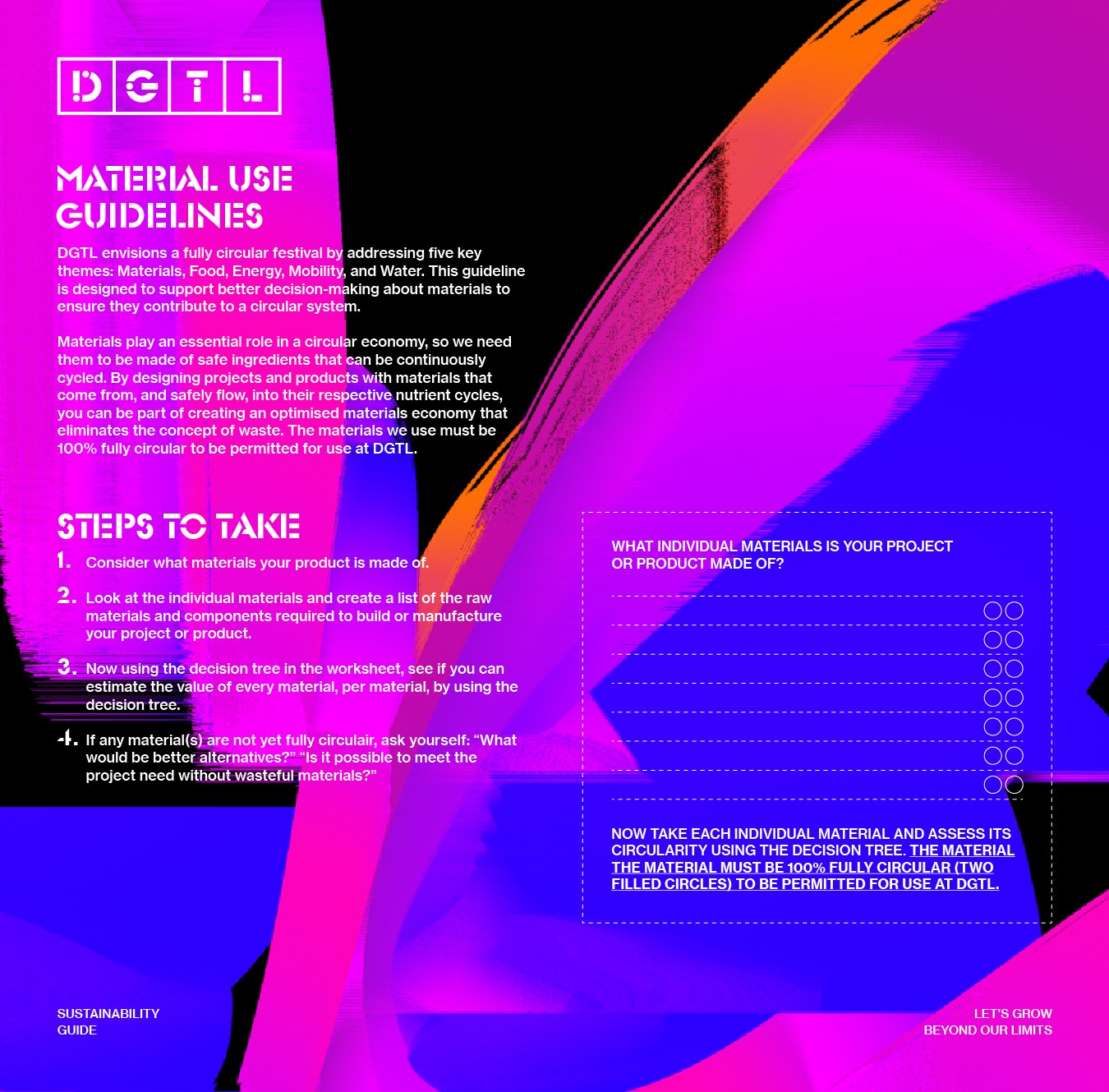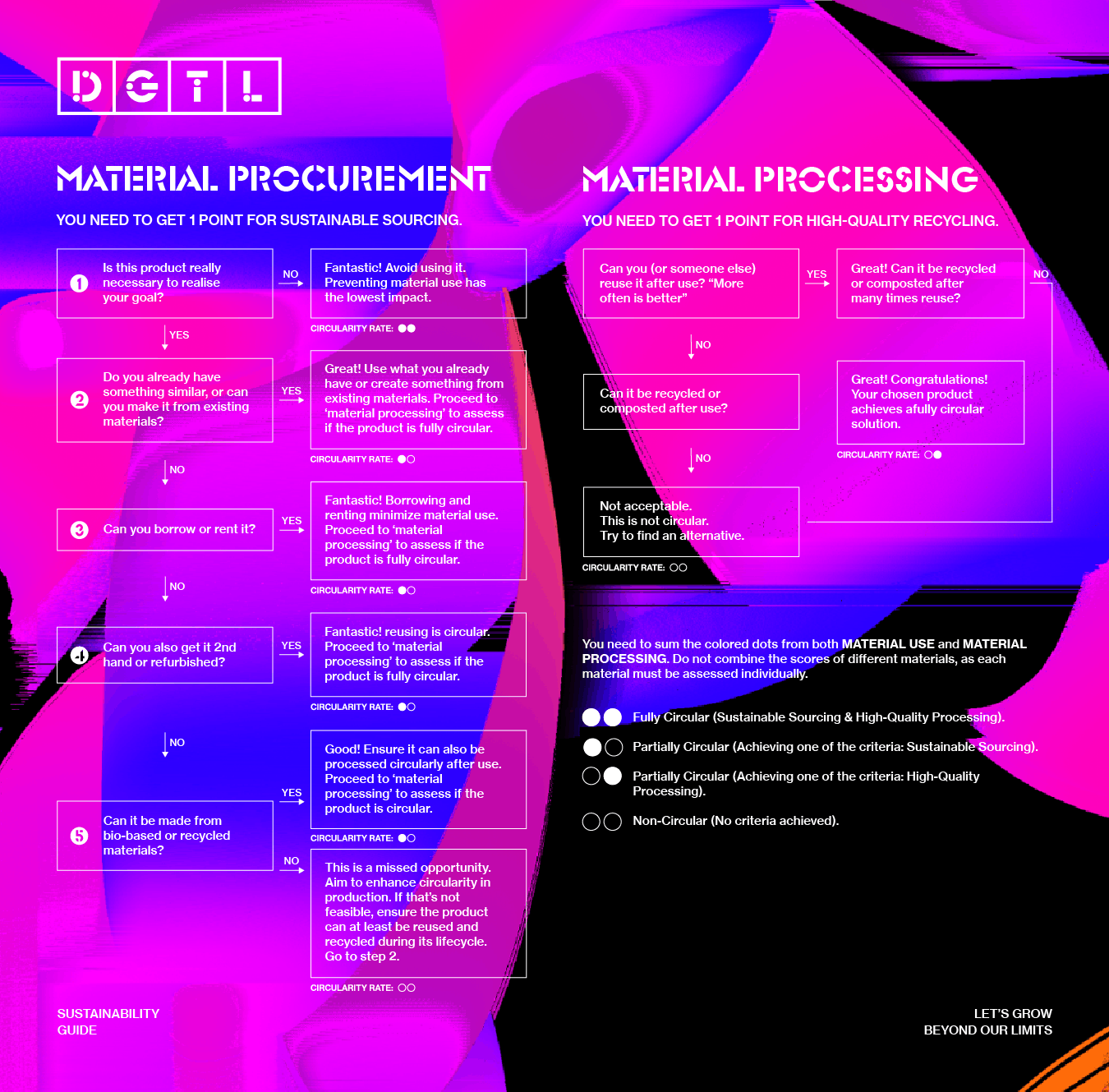From waste to value: How DGTL applies circularity before, during and after the festival
Festivals are experiences where music, art and people come together, yet behind the magic of packed stages and dancing crowds lies a harder truth. Mountains of waste, massive amounts of material and a significant ecological footprint have long been part of the standard festival model. At DGTL we decided to break that pattern. Since 2013 we have been working towards becoming a circular festival, a goal we pursue edition after edition, knowing it is a continuous journey and never fully “finished.”
Rethinking materials from the start
We began tackling the problem of waste by fundamentally rethinking the materials we bring onto the grounds. Single-use plastics like cups and tokens quickly gave way to durable hardcups and a cashless system, cutting down an enormous amount of unnecessary trash from the start. Because resource extraction and material handling are responsible for a large share of global emissions, taking action here was both urgent and logical. Yet these were only the first steps. Our ambition is to continuously move closer to a system where every material that enters the festival is either reused or recycled at the highest feasible level.
To make this ambition tangible, we have built a system that is visible everywhere on site, from well-marked recycling stations and backstage sorting flows to reusable signage designed for multiple editions. Where possible, we also rent materials so that after the festival they can be returned to suppliers and reused at other events. Each step is guided by our Resource Ladder and Procurement Ladder, which are also included in the blueprint and accompanying documentation. Each of these elements brings us closer to our goal of achieving near-complete waste separation and minimizing residual waste per visitor.


Rethinking resources before the festival
Our road to circularity always begins in the preparation phase, because everything depends on the decisions made long before the doors to our festival open. As our Sustainability Manager, Esmee Bouwmeister, explains, “Circularity doesn’t start on-site, it starts months before the festival when we decide what materials are even allowed through the gates.” Together with suppliers we carefully map which materials will enter the site and what will happen to them afterwards. This process ensures that every item has a defined purpose and destination before it arrives. “Every item that enters DGTL already has a plan for its second life; reuse, recycling, or return,” Esmee adds.
Stage design and signage are built to last for multiple editions, or rented so they can be reused at other festivals. Crew members are provided with durable bottles, disposable plastics have been eliminated, and everything that enters the grounds has a clear plan for its second life.
Key before-actions at a glance:
Hardcups and deposit-system coffee cups replace disposables.
Reusable signage with timeless design.
A decoration checklist guides suppliers to use sustainable, reusable materials and ensures all items can be recycled or composted after the event.
A supplier questionnaire ensures full insight into all materials entering the site, enabling proper collection and planning for 100% reuse and recycling.
A clear Materials Policy shared with all suppliers.
Designing circular systems on-site
When the festival comes alive and thousands of visitors gather, our circular system becomes tangible in practice. As Esmee puts it, “A festival is like a temporary city. If circular systems can work here, they can work anywhere.”
A festival truly functions as a temporary city where food, drinks, travel and consumption converge. In the midst of that intensity it is crucial that sustainable systems not only work effectively, but also feel intuitive and appealing.
Visitors experience this most directly through:
Recycle stations, where cups are never discarded but continuously returned and exchanged for clean ones.
Reusable plates, which after collection and cleaning are ready to be used again at DGTL or rented out to other events.
Circular catering for crew and artists, with reusable backstage materials and local products wherever possible.
Recycling station at the entrance, where prohibited items are collected in crates and sorted for high-quality reuse or recycling.
Green Teams, enthusiastic volunteers who guide visitors and crew in separating waste and using circular systems on-site.
A central Recycle Hub, where all collected resource streams come together for sorting, processing, and closing the loop.
On site, the recycle stations and the central recycle hub play a key role. This is where different material streams come together, from glass and organics to metals and cardboard. Our Green Teams actively guide visitors, answer questions and make separating waste as simple as possible. Innovation is becoming an increasingly important element of this approach. We have experimented with:
AI-driven recycle bins.
Mobile robots that invite visitors to hand in their cans.
In this way the festival becomes a living lab, where technology and behaviour work hand in hand, and where circularity becomes visible and tangible.
Closing the loop after the last beat
When the final act has played and the lights go down, another equally important part of the process begins. The dismantling of the festival is fully designed around reuse and high-value processing.
Materials like wood, cables, metals and textiles are carefully separated and either stored for the next DGTL edition or returned to rental suppliers.
What cannot be reused directly is sent to certified recyclers to preserve valuable resources.
Every area of the festival site, from storage and catering to backstage and production hubs, follows its own collection plan, ensuring materials stay separated and retain their quality. “We analyse every kilo of material: what came in, what was reused, and what was recycled. This data tells us how to do better next time.”
Afterwards, we analyse all these streams in detail: how many kilos came in, what was reused, and what was recycled at which quality level. Sometimes we encounter new or unexpected materials that don’t fit neatly into our system, showing us where we can improve. These insights form the foundation for our own progress, and for knowledge sharing with partners, innovators and policymakers. Our aim is for DGTL to serve as a practical showcase of the circular economy in action, while continuously learning from the challenges that arise.
Beyond the festival grounds
The value of this approach reaches far beyond the festival industry. If we can make a circular system work in a festival, the same principles can be applied within our cities and communities. DGTL demonstrates that circularity is not just an abstract concept, but a tangible reality, even though we encounter challenges along the way. Our role as a living lab allows us to learn from these challenges and document new solutions for future editions. As Esmee explains, “Circularity is not a checklist, it’s a mindset we apply edition after edition, always learning and improving.” We want to prove that waste does not have to exist and that every material can be given a second, third or even tenth life, provided you think about it consciously from the very beginning.
Our ambition remains to work towards a circular festival, edition after edition. We focus on closing loops as much as possible within our festival grounds, while also gradually gaining more control over material flows outside the fences. But perhaps even more important is showing, every edition, that circularity can be inspiring and unifying. Visitors, crew, artists and partners all become part of a movement that is far bigger than the festival itself. Because if we can dance together to the beat of music, we can also build together towards a future in which resources are never lost again.